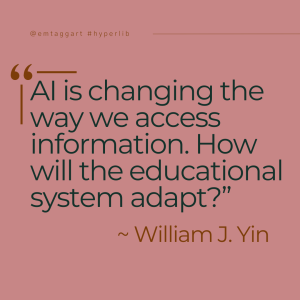
For my innovation assignment, I propose a way to ethically integrate AI tools in high school research. The school librarians and teachers would collaborate to teach an AI sandbox series for high school students in their school library focused on a research assignment. This three-part series of hands-on, interactive work sessions to introduce students to emerging AI technology that can help them improve their writing and research projects within ethical guardrails.
Here is the action brief:
The AI sandbox series will convince high school students that by learning how to use AI tools ethically they will gain practical skills to improve their research and writing which will help them with academic and career success because understanding what AI is and knowing how to use AI tools is necessary to navigate and thrive in an increasingly digital and information-rich world.
This is well within the Library 2.0 model we’ve been studying this semester. Casey & Savastinuk say that “Much of Library 2.0 involves building change around the needs of your community of users.” Well, AI is here and people are using it. Rather than resisting or reacting to the emerging technology, I think librarians need to adapt and respond to how this technology is now part of our information ecosystem and infrastructure.
In this presentation, I share research about the use of AI and the attitudes of high school students towards it. I know there are a lot of strong feelings about AI, but it is here, and people are using it. The school library is the perfect place to give students a foundational understanding of AI technologies and their ethical applications to research, writing, and assessing information.
You can download the slides here.
References used in the presentation:
- American Association of School Librarians. (2019, June). Role of the school library. https://www.ala.org/sites/default/files/aasl/content/advocacy/statements/docs/AASL_Role_of_the_School_Library.pdf
- Ashikuzzaman, M. (2024, November 4).Functions and objectives of the school library. LIS Education Network: Library & information science academic blog. https://www.lisedunetwork.com/functions-of-school-library/
- Casey, M.E. & Savastinuk, L.C. (2007). Library 2.0: A guide to participatory library service. Information Today, Inc.
- Schiel, J., Bobek, B., & Schnieders, J. (2023, December). High school students’ use and impressions of AI tools. ACT Research. https://www.act.org/content/dam/act/secured/documents/High-School-Students-Use-and-Impressions-of-AI-Tools-Accessible.pdf
- Center for Digital Thriving at the Harvard Graduate School of Education. (2024). Teen and young adult perspective on generative AI: Patterns of use, excitements, and concerns. https://digitalthriving.gse.harvard.edu/wp-content/uploads/2024/06/Teen-and-Young-Adult-Perspectives-on-Generative-AI.pdf
- Schiel, J., Bobek, B., & Schnieders, J. (2023, December). High school students’ use and impressions of AI tools. ACT Research. https://www.act.org/content/dam/act/secured/documents/High-School-Students-Use-and-Impressions-of-AI-Tools-Accessible.pdf
- Yin, W. (2024, January 24). Will our educational system keep pace with AI? A student’s perspective on AI and learning. Educause Review.https://er.educause.edu/articles/2024/1/will-our-educational-system-keep-pace-with-ai-a-students-perspective-on-ai-and-learning
Leave a Reply